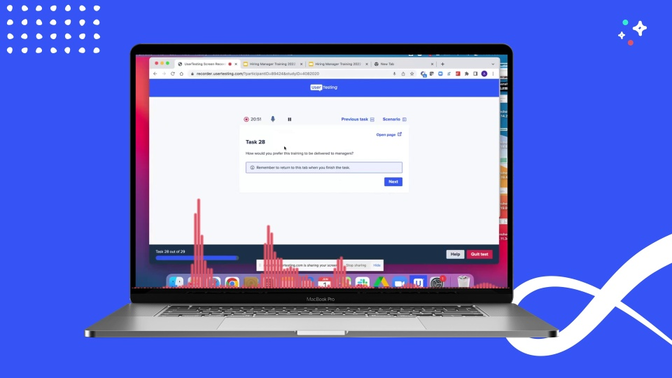
Employee-centric programs: what they are and how they benefit your organization

Being an HR professional right now isn’t easy. With the transition into hybrid or fully remote working styles, balancing the “Return to Office” tightrope, and monitoring the latest trends with the Great Reshuffle (on top of your normal work) there’s a lot of pressure to support the ever-growing needs of your organization. HR teams are overstretched, which has now become the norm, with leaders that want things done yesterday.
But, with the rise of employees wanting a company culture that aligns with their values and supports them through all their life moments, companies have to re-think their current People structures to place employees at the center. Direct and current feedback is one of the most impactful ways to do this. There are many opportunities for HR professionals to gain feedback, whether through engagement, benefits, or performance reviews, to name a few. But typically, the only time feedback is received on HR programs or protocol, if at all, is during the annual engagement survey that happens at a specific point in time. This type of feedback is reactive and usually comes in too late to make a measurable difference in adjusting current programs or removing any negative feelings harbored from a poor experience.
So, how can HR teams take a more proactive and innovative approach to understanding their employee’s needs and ensure they’re on the right track—before a program is launched? Over the next few weeks, we’ll release a three-part series detailing the benefits of having the employee’s voice at the center of your programs. This will cover common pitfalls and issues you may run into and different methods of including your employees’ perspectives.
What are employee-centric programs and their benefits?
Having the employee’s voice at the center of HR programs is becoming increasingly adopted in the industry. Often, HR programs and processes are built with the end-user in mind. This is a solid concept, as they’re the ones who will end up using whatever it is you’re rolling out.
But, by taking it a step further with employees at the center, helping you co-create with a constant feedback loop (especially in the ideation and early phases), this will ultimately yield something more personable to the employees who are participating and involved.
By building employee-centric programs and processes, your workforce is taken along on the journey. This ultimately leads to better adoption and increased clarity, creating a bigger impact on your workforce and decreasing turnover rates.
1. Expect increased adoption and engagement
The “if you build it, they will come” attitude that HR is historically known for doesn’t fly with today’s workforce. Employees want to be a part of the conversation and HR programs shouldn’t be the brainchild of only the HR department. Instead, they should be co-created along with employees.
Without the employee’s voice to guide us, HR teams could potentially be creating perceived solutions for problems that:
1. Don’t interest employees
2. Aren’t the right kind of solution that employees are looking for
3. Don’t address a problem that needs solving
We must start embracing what employees say, even if they’re not a seasoned HR professional. These programs and processes are created for them, so keeping them shut out until after you roll out a project, and then asking for feedback, won’t align if you’re looking to create an engaging program.
Bringing employees along on the journey and giving them a seat at the table to co-create programs improves adoption and engagement by:
1. Giving them exactly (within reason) what they want
2. Helping pinpoint the best solution for your organization
3. Clearly identifying the problem that needs solving
Without understanding how employees want to give and receive feedback while offering some improvements along the way, it’ll be difficult for employees to be engaged and adopt the new process.
2. Employees will have improved clarity and understanding
It’s not the intent of HR to drive focus away from an employee’s day-to-day work to engage with HR communications, but it is up to the HR team to be clear and concise. This way, employees aren’t spending an endless amount of time figuring out what they’re being asked to do, or even better, getting bored halfway through the ask!
At UserTesting, we’ve taken this approach very seriously. By having a subset of employees give us feedback on different communications, surveys, training materials, system help text, and even performance reviews. We’ve baked this feedback into our DNA to ensure we’re getting the most out of any touchpoint we have with them. For example, we now always run our employee surveys pre-launch through the UserTesting platform, to ensure that we’re getting actionable data and feedback and are being mindful of what we put in front of our employees. To see this in action, check out the below video.

This process of feedback not only saves the employee’s time when they’re reading through your communication, but it also helps to simplify your asks so that they’re more likely to complete the action you’re requesting from them.
By having employees’ feedback on the clarity of HR communications, you’re ensuring that it resonates with them, gives them understanding and that they can answer questions in a more thoughtful way. Ultimately, this results in better and more actionable data for you.
3. Your organization will see a larger impact on behavior changes and lower attrition rates
The end goal of rolling something out, whether it’s a training or program, is to change or influence behavior. Sometimes, though, HR teams lose sight of this when in the midst of creating. We can occasionally get so married to project delivery that we lose sight of the end goal—having impactful change on an organization. If, in the end, the new program you rolled out doesn’t improve employees' lives, was it actually worth creating?
Some HR teams rely too heavily on training and information. But if you’re not influencing your employees and positively changing their lives, you’re ultimately wasting time and resources creating something that no one cares about. That leads to a lot of dollars wasted on employees sitting through training, with the outcome of little results and unchanged behavior.
And with the Great Rethink and the Great Regret coming into play, employees have started to re-evaluate their connection and commitment to certain working environments and even their relationship with their roles altogether. With over 70% of tech workers considering a job change this year, the highest amount compared to employees in other industries, Gartner has urged organizations to adopt a more “human-centric” work model.
When you create a process by and for the employee, you have a higher chance of capturing their attention, changing their behavior, and eliminating demotivators. When employees are empowered to be a part of the conversation, they’re more likely to adopt what you are rolling out. Not only will you have built-in ambassadors for the program, but you’re now able to personalize the experience, taking into consideration your organization’s culture.
Another benefit? Encouraging the feelings of connectedness and belonging as the company actively listens to their employees and responds in a real and authentic way, resulting in attracting and retaining employees.
A final word
At UserTesting, we’re learning to involve employees more and more in developing our programs and mass communications to lead to impactful change. This is also a great way to crowdsource ideas on how to resolve specific issues like leadership competencies and performance management.
Capturing feedback on how these programs will affect employees’ lives and receiving suggestions on how to improve leads to less time spent reading and more time supporting the change you want to see. Feelings and people matter in HR, and it’s time we start solidifying this by placing employees at the forefront.
At the end of the day, “in HR… employees are our customers,” says Ben Russo, L&D Program Manager at UserTesting. He continues, “If we include our customers to truly understand what they want and how they experience our systems and programs, we'll be able to create an optimal solution that’s tailor-made for them.”
Read next
To learn more about employee-centric programs, read the other posts in this series:





